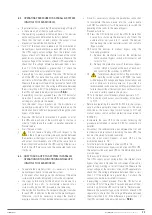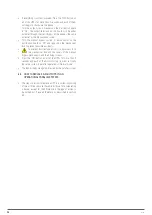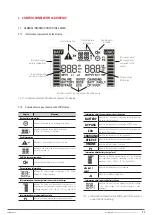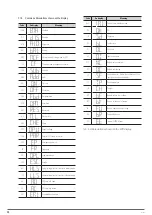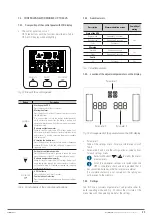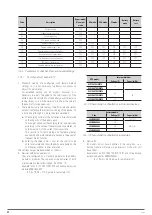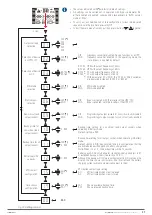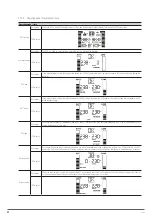
17
Fig. 11.
Rack-type mounting in a 19” cabinet with PDU.
5.1.5.8. Preliminary considerations before connection.
•
In the description of this manual, reference is made to the
connection of terminals and switch operations that are
only available in some versions or devices with extended
backup. Ignore the related operations if your unit does not
feature them.
•
Thermal control of these devices is carried out with the
passage of forced air from the front to the rear.
The front surface and about 15 cm on the rear side should
be left free of obstructions to facilitate the free circulation
of air for ventilation.
•
Follow and respect the instructions described in this section
referring to the installation of a single device or a system
in parallel.
•
Protection or external manual bypass board:
The system will have at least one short-circuit
protection on the UPS’s power supply line.
It is advisable to have an external manual bypass board
fitted with input, output and manual bypass protections
in single systems.
For parallel systems,
it is essential
to have a
distribution or manual bypass board. The board’s
circuit breakers must be able to isolate a UPS from
the system in the event of a fault and power the loads
with the others, either during periods of preventative
maintenance or during breakdown and repair.
•
Upon request, we can supply an external manual bypass
board for a single device or parallel system.
You can also choose to manufacture it, taking into account
the version and configuration of the device or system
available and the documentation contained in the CD-ROM
or pen drive relating to ‘Recommended installation’.
•
In the documentation supplied with this user manual
and/or on the CD-ROM or pen drive, information is
available on ‘Recommended installation’ for each input and
output configuration. This documentation includes wiring
diagrams and information about the sizes of the protections
and the minimum cross sections of cables connected to the
device according to their rated working voltage. All values
are calculated for a
maximum total cable length of 30 m
between the distribution board, equipment and loads.
For longer lengths correct the cross sections to avoid
voltage drops, respecting the regulations or standards
corresponding to the country.
In the same documentation and for each configuration,
information for ‘N’ units in parallel, as well as backfeed
protection characteristics, is available.
•
In parallel systems, the length and cross section of
the cables that run from the distribution or manual
bypass board to each UPS and from these to the board will
be the same for all of them without exception.
•
The cross section of the cables must always be considered
in relation to the size of the terminals of the switches, so
that they are correctly fastened across their entire cross
section for optimum contact between the two elements.
•
Only rated currents are printed on the nameplate of the
equipment as indicated by the EN-IEC 62040-1 safety
standard. For the calculation of the input current, the power
factor and the equipment's own performance have been
considered.
Overload conditions are considered a non-permanent
and exceptional working mode, and will not be taken
into account in the application of the protections. Do not
connect appliances or devices which may overload the UPS
to the terminals and/or outlets, such as motors.
•
If peripheral input, output or bypass elements such as
transformers or autotransformers are added to the UPS or
parallel system, the currents indicated on the nameplates of
these elements must be taken into consideration in order to
use the appropriate cross sections, in compliance with local
and/or national Low Voltage Electrotechnical Regulations.
•
When a galvanic isolation transformer is added to a UPS
or parallel system as an optional extra, as standard or
independently, either on the input line, at the output or
both, it must be fitted with protection against indirect
contact (differential circuit breaker) at the output of each
transformer, since, due to its own insulation properties, it
will prevent the tripping of the protections placed on the
primary of the isolation transformer in case of electric shock
on the secondary (output of the isolation transformer).
•
We remind you that all the isolation transformers installed
or factory supplied, have the output neutral grounded
through a bridge between the neutral terminal and ground.
If the isolated output neutral is required, this bridge must be
removed, taking the precautions indicated in the respective
local and/or national low voltage regulations.
•
This device is suitable for installation in networks
with TT, TN-S, TN-C or IT power distribution
systems, taking into account at the time of installation the
particularities of the system used and the national electrical
regulations of the destination country.
•
The SLC TWIN RT2 features terminals for the installation
of an external emergency power off button (EPO) or, failing
that, a single device must be installed to cut the power
supply to the loads in any operating mode.
5.1.5.9. Preliminary considerations before connection, regarding
the batteries and their protections.
•
SLC TWIN RT2 devices from 0.7 to 3 kVA incorporate the
batteries in the same box as the device, except for B0, B1
and higher power models.
•
The battery protection of the device and of any accumulator
module is always by means of internal fuses that are not
accessible to the user.
SLC TWIN PRO2
UNINTERRUPTIBLE POWER SUPPLY SYSTEMS (UPS)
USER MANUAL























